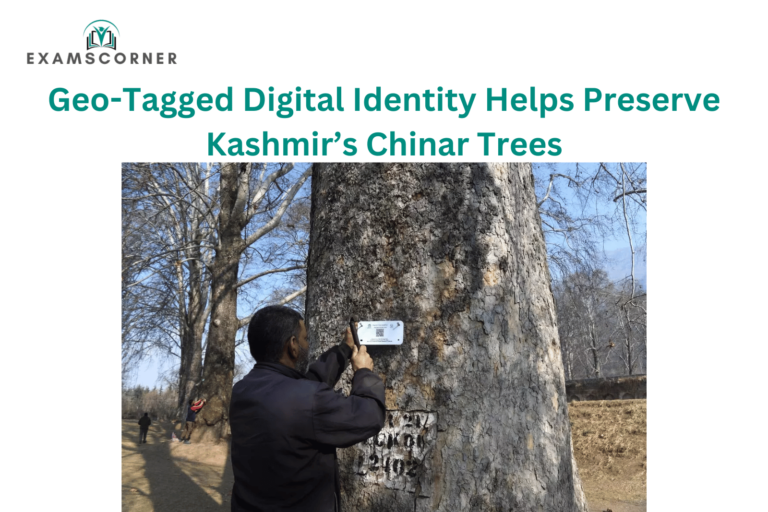A Revolutionary Step to Save Chinar Trees
Facing destruction from rapid urbanization and infrastructure projects, Kashmir’s iconic chinar trees (Platanus orientalis) have been granted a new lease on life. Thanks to a geo-tagged digital identity system, these majestic trees are now being closely monitored and managed. This innovative initiative, introduced by the Jammu & Kashmir Forest Research Institute (JKFRI), mirrors the Aadhaar card system, ensuring each tree’s health and history is meticulously recorded, in this article we were know about Geo-Tagged Digital Identity Helps Preserve Kashmir’s Chinar Trees.
What Is Geo-Tagging?
Geo-tagging is the process of attaching geographical identification data, such as latitude and longitude, to an object or location. In this case, geo-tagging is applied to individual chinar trees, allowing their exact location to be pinpointed on a digital map. This technology, combined with QR codes, creates a detailed database for each tree, ensuring better monitoring and management.
The Digital Tree Aadhaar Initiative
The JKFRI’s ‘Digital Tree Aadhaar’ program assigns a unique identification number to each chinar tree. For example, the famous chinar at Lal Chowk is tagged as CG-JK010088. Metal cards with barcodes are affixed to the trees, providing information such as their location, height, girth, and overall health. These barcodes can be scanned to reveal additional details, including the tree’s age, making the initiative both informative and tourist-friendly.
Syed Tariq, project coordinator at the JKFRI, explained, “Around 10,000 trees are being metal card-tagged as of now. This will not only aid in the effective management of chinar trees but also allow tourists to appreciate their historical significance by accessing detailed data about each tree.”
Declining Numbers of Chinar Trees
A census conducted by the JKFRI in 2021 revealed alarming statistics. Once numbering approximately 40,000, the chinar tree population in Kashmir has steadily declined due to rapid urbanization and the expansion of highways. According to JKFRI data, around 28,560 chinar trees have been geo-tagged so far, with fresh plantations included in recent years.
“The aim of the JKFRI is to establish a comprehensive database of chinar trees using GIS-based and QR code-enabled surveys,” Mr. Tariq added. This database will ensure the long-term preservation and proper management of these trees, preventing illegal logging and neglect.
Expanding the Initiative
While the current focus is on the Kashmir Valley, the program will also cover chinar trees in Jammu’s Chenab Valley and the Pir Panjal Valley. Ganderbal district, home to the world’s third-largest chinar tree with an astonishing girth of 74 feet, boasts the highest number of chinars in the region. Dr. Tariq noted, “We plan to record the top 20 chinars in Kashmir, with girths ranging from 60 to 74 feet.”
The Majestic Chinar: A Symbol of Kashmir
The chinar tree, also known as the oriental plane, holds immense cultural and ecological significance in Kashmir. These trees can grow up to 30 meters in height, with girths ranging from 10 to 15 meters at the ground level. Once abundant, chinar groves are now a rare and treasured part of the region’s landscape.
The Role of Geo-Tagging in Conservation
Geo-tagging has emerged as a powerful tool in conservation efforts. By creating a digital record of each tree, this technology ensures better protection against illegal activities such as unauthorized logging. Additionally, it allows scientists and policymakers to track the health and growth of chinar trees over time, promoting their preservation for future generations.
Conclusion
The geo-tagged digital identity initiative is a groundbreaking step toward safeguarding Kashmir’s natural heritage. By leveraging modern technology, the JKFRI has not only provided a way to monitor and manage the chinar trees but also raised awareness about their significance. With continued efforts and public support, these majestic trees will continue to stand tall as enduring symbols of Kashmir’s cultural and ecological legacy.



